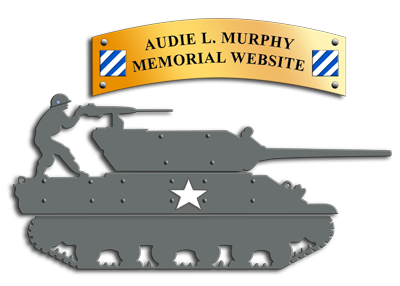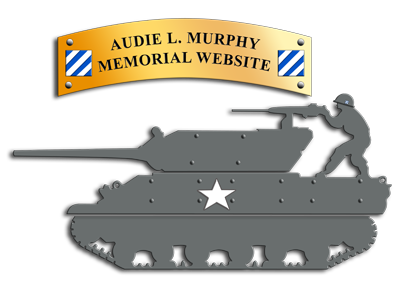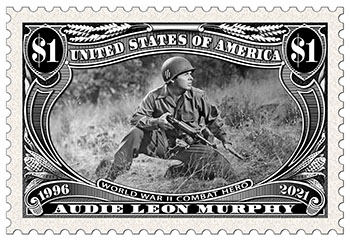|
On August 14, 1996, Marty Black, an American Airlines employee and an avid amateur military historian "rediscovered" the famous M10 Tank Destroyer battle site near Holtzwihr, France where Audie Murphy earned his Medal of Honor on January 26, 1945. Later, Marty had the opportunity to revisit the Holtzwihr site several more times. The accounts and photos below are his written records and documentation of these subsequent visits. They are interesting and provide a some historical insight on events surrounding Audie Murphy.
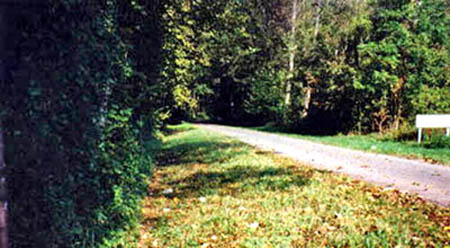
|
Looking north from a Nazi's point of view toward the M10 location.
Photo by Marty Black
|
Written August 18, 1997 by Marty Black. Finally got another Zurich layover, and drove 2 hours NW to Alsace, France, to revisit the Audie Murphy Medal of Honor battlesite outside Holtzwihr. Found the site ... and noticed that a pile of ammunition and commo wire that I had placed at the base of a tree on my last visit (August 14, 1996) was gone. Also, there was evidence that other "seekers" had visited the site with a metal detector. Several areas of turned over dirt, and a growing pile of [tank destroyer] parts tossed into the "machine gun hole."
Swept around the "machine gun hole" and found the handle from a .30 cal [machine gun] ammo can, as well as more spent casings. (The fact that not a single M1 clip was found is evidence that this was a machine gun emplacement.) So much [tank destroyer] junk has been piled in the hole, that I didn't sweep the depression itself. "Junk" included chunks of armor plate about 1-1/2" thick, parts of what I believe to be the rail (or handhold) that ran around the outside of the turret (that tankers normally hung their musette bags from), a large exhaust pipe, lots of valves and brackets, a few rubber hoses, several bolts, a large gear, and a host of unidentifiable steel items. I went a few feet farther into the woods and dug up the metal "cat's eye" frame from the tail-light!* Also in this area, I found many, many rusting steel "links" for .50 cal ammo and many spent .50 casings. Also found all the hardware (spring clips, buckles and buttons) from a musette bag, and fragments from a GI helmet liner and raincoat (or poncho.)
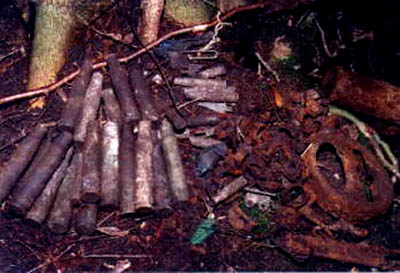
|
30.06 and.50 Caliber Machine Gun Casings and M10 "Cat's Eye"
Photo by Marty Black
|
It would appear that, after the battle, the knocked-out and burned [tank destroyer] was pushed off the farm path into the field, just "in" from the [machine gun] hole, where it either exploded or was intentionally blown up, considering all the parts strewn in this area. It would also appear that the .50 cal casings and links that had accumulated in the open turret and on the [tank destroyer] deck, spilled to the ground at this time. This portion of the field has now been turned into a "community forest" whereas the [southeast] part of the field (closest to the town) is still a corn field.
I then walked deeper into the woods, angling toward the cornfield. Many shallow [artillery] shell holes are still visible, with lots of shrapnel. This is the area that Murphy called [artillery] fire down on, while the German counter-attack was in progress.
The discovery of field phone wire, blown-up parts of what appear to be from a [tank destroyer] or tank, the .50 cal casings and links, and the [machine gun] hole all correlate to Murphy's own description of the event in his book TO HELL AND BACK ...
Weather was quite hot, mid-80's and humid. No breeze at all. Lots of mosquitos in the woods, and there seemed to be a spider and web between every tree! Ground was a bit hard to dig. And I had been awake for about 24 hours at that point. But finding casings that Audie Murphy most probably fired (as well as other evidence of his Medal of Honor feat) was quite a historical thrill! Can't wait to go back again! MB
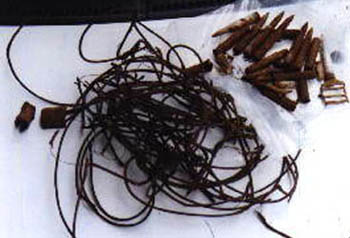
|
Land Line - Field Telephone Wire and
.30 Caliber Machine Gun Casings
Photo by Marty Black
|
Written August 18, 1997 in an email by Marty Black. I got another trip to Zurich, and drove to Holtzwihr. I was dead-tired and the weather was a bit cool and damp, but I knew this would be my last trip before winter set in, and the days became very short over there. I was anxious to get another bit of the [tank destroyer], after sending that cat-eye to you. I only spent 3 hours there this time, because I was worried about the 2-hour drive back to Zurich, in my exhausted condition. I did bring home 4 more .50 cal casings. Do you want 2 more? These are all good ones, no chipped necks, no dents ... I also found lots more .50 cal links, but they were all in the same "poor" shape as the other ones I found. Plus a few more .30 cal casings and shrapnel.
I did find lots more [tank destroyer] parts though, and I set aside those that I found interesting. Unfortunately, when I decided to leave at 3 pm, I had a rather large pile of about 20 pounds of rusty steel! And no practical means of carrying this stuff back, no room in my suitcase! And with my metal detector bag, jungle boots, coveralls, etc., I was overburdened already ... So, I whittled the pile down to 4 items: one nice piece of steel with [olive drab] paint remaining, two valve assemblies of some sort (I have an 85 year old friend who was a Tank Platoon CO in the 3rd Armored, and I hope he can identify them), and the stainless-steel/ceramic insulator mount for the "whip" antennae! Still with [olive drab] paint on it! I've checked that photo book again, and I've got 3 or 4 good "matches with M10's, but no good closeups of the M18 or M36. So I'm inclined to believe Audie stood on an M10 unless you guys know different.
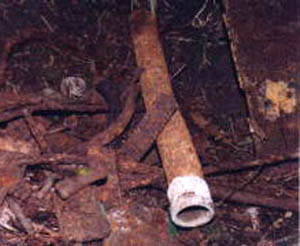
|
Salvaged Parts From The M10 Tank Destroyer
Photo by Marty Black
|
I also took some photos, which I will send you when I get the film developed. I "swept" the ditch where the 2-3 Germans tried to flank Audie, but all I found was one damaged .50 cal casing, and lots of discarded junk! The ditch was apparently at least a foot deeper back then, and I would bet a "hit" with my metal detector, fervently hoping it would be a .50 cal bullet or two, and I'd dig and dig and dig with my little garden tool, but all I got was soda cans and other aluminum junk. That search got "old" real quick! ... MB
Hi ... I am almost finished reading TO HELL AND BACK again ... I had read it decades ago, but had essentially forgotten most of it, and had only read an excerpt from the Holtzwihr battle in an "After The Battle" magazine ... I resisted the temptation to read that section of TO HELL AND BACK first, and started at the beginning ... Have only got about 20 pages to go ...
At any rate, the reason I write is that I was astounded at how accurate [Audie Murphy's] description of the Holtzwihr battle site compares to what I've seen ... At first he confused me a bit about the "U" shape, but when I read it a second time, the light bulb went on! To quote from page 238 of my Bantam paperback:
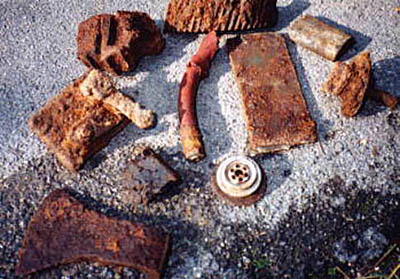
|
More Salvaged Parts From The M10 Tank Destroyer
Photo by Marty Black
|
"We are at the butt-end of a rough U, whose sides are formed by fingerlike extensions of the woods stretching toward Holtzwihr. Directly before us are flat open fields beyond which I can see a church steeple and housetops in the village, a mile away. The narrow road over which we have been pounding our feet leads from the woods to the town."
1. [If you] turn my ... map upside down ... the U is obvious. The right side of it is the natural woodsline on the right (west) of the narrow farm road. The bottom of the U, where [Audie] was, is where the natural woods cuts across the road, and off to the left (east) and borders along the western edge of town, that being the left side of the U.
2. From the photos, you can see the rooftops at the "top" of the U, and although they are only about 1/2 mile from the battleground, I suspect these are of post-war construction ... The actual wartime "city centre" is probably almost a mile away, and cannot be seen in my photos. The city center is to the left of my "cornfield photo" and is obscured by the "planted trees." And yes, the church steeple is still there, in the middle of the older-part of town.
3. And of course [Audie's] "narrow road" is still there, and still very narrow, as is the ditch to the right (that I photographed.)
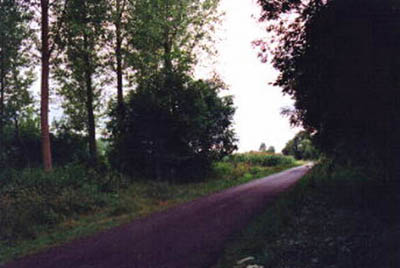
|
Deeper Inside the Woods From Audie's Point of View
Photo by Marty Black
|
Uncanny, isn't it?! I suspect that maybe [Audie] visited that site after the war, perhaps with Spec McClure or whoever helped him write the book, because his description is too incredibly accurate for a one-time-battle memory.
One more thing - there is a slight ditch (depression) on the left side of the road, in the area of the machinegun casings, .50 cal casings and [tank destroyer] debris, and I suspect it was here that the first [tank destroyer] proceeded forward off the road, toward the town, got stuck muzzle down, and was then abandoned.
Webmaster Footnote:
When Marty discovered the spot, it was natural that some people would doubt the location's authenticity. To help clear up confusion, a comparison of unearthed components Marty says comes from Audie's M10 tank destroyer with a tank destroyer on exhibit in a military museum can be made. The photos below compare an excavated piece of tank with the left rear light lens cover on an M10 on display at the Aberdeen Ordinance Museum at Aberdeen Proving Grounds, Maryland.
As it turned out, time has proven Marty to be correct. It should come to no one's surprise that the people of Holzwihr, France never forgot. Several years after Marty's discovery, the town erected a memorial dedicated to Audie Murphy on the very same spot. You can see this memorial by clicing on the Holzwihr, France graphic near the top of the page.
|





